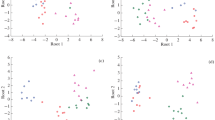Abstract
The serotonin and noradrenalin content in the cerebral cortex, hypothalamus, and mesencephalon was investigated spectrofluorometrically in 12 cats on the 5th–6th day after the production of a pathological focus in the region of the occipital cortex. Diffuse changes of brain activity were recorded on the EEG at this period: spike-like waves and slow waves of increased amplitude. A considerable increase in the serotonin concentration was observed in the cortex, with the effect predominant in the region immediately adjacent to the pathological focus. A tendency for the serotonin level to fall was observed in the hypothalamus and mesencephalon. The noradrenalin concentration in these brain structures showed no significant change. The role of serotoninergic structures of the brain in the mechanisms responsible for restoring the functional state of the brain after experimental injury is discussed.
Similar content being viewed by others
Literature cited
P. K. Anokhin, Problems of the Center and Periphery [in Russian], Gor'kii (1935).
P. K. Anokhin, Internal Inhibition as a Problem in Physiology [in Russian], Moscow (1958).
N. A. Arkhipova and V. V. Gnezditskii, “Quantitative evaluation of the dynamics of rhythm binding on a model of a local lesion of the rabbit brain,” in: Proceedings of the 6th All-Union Conference on Electrophysiology of the Central Nervous System [in Russian], Leningrad (1971), pp. 17–18.
N. A. Arkhipova, “Relationship between the global EEG and neurogenic activity of the cortex during the development of an experimental tumor of the cerebral hemispheres,” Byull. Éksperim. Biol. i Med., No. 7, 17 (1973).
É. A. Asratyan, Physiology of the Central Nervous System [in Russian], Moscow (1953).
É. A. Asratyan, The Problem of Compensatory Adaptation [in Russian], Moscow (1960).
N. Yu. Belenkov, “New aspects of the structural and functional organization of the brain,” Proceedings of the 23rd Conference on Problems in Higher Nervous Activity [in Russian], Gor'kii (1972), pp. 5–7.
S. N. Kozhechkin, “Microionophoretic study of the effect of biogenic amines on unit activity in the rabbit visual cortex,” in: Physiological Mechanisms of Memory, Pushchino-on-Oka (1973), pp. 89–97.
N. E. Anden, A. Dahlström, K. Fuxe, et al., “Ascending monoamine neurons to the telencephalon and diencephalon,” Acta Physiol. Scand.,67, 313 (1966).
N. E. Anden, K. Fuxe, and U. Ungerstedt, “Monoamine pathways to the cerebellum and cerebral cortex,” Experientia,23, 838 (1967).
K. Fuxe, “Distribution of monoamine nerve terminals in the central nervous system,” Acta Physiol. Scand.,64, Suppl. 247 (1965).
A. S. Welch and B. L. Welch, “Solvent extraction method for simultaneous determination of norepinephrine, dopamine, serotonin, and 5-hydroxyindoleacetic acid in a single mouse brain,” Anal. Biochem.,30, 161 (1969).
Author information
Authors and Affiliations
Additional information
Translated from Byulleten' Éksperimental'noi Biologii i Meditsiny, Vol. 80, No. 8, pp. 20–23, August, 1975.
Rights and permissions
About this article
Cite this article
Vekshina, N.L., Sovetov, A.N. Effect of a unilateral cortical lesion on the monoamine content in the cat brain. Neurosci Behav Physiol 7, 5–8 (1976). https://doi.org/10.1007/BF01148739
Received:
Issue Date:
DOI: https://doi.org/10.1007/BF01148739



